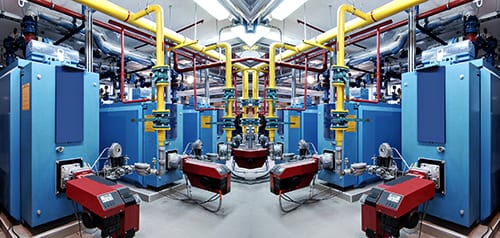Parts 1, 2, and 3 of this series focused on makeup water system and condensate/feedwater monitoring for high-pressure steam generators, and primarily those for the power industry. However, many thousands of lower-pressure boilers exist at industrial plants around the globe, and these also require accurate monitoring and chemistry control. In this post, we will focus on monitoring water and steam chemistry in lower-pressure boilers, specifically issues with condensate return.
A complicating factor at many industrial facilities is the often large and complex steam feed/condensate return network. Depending on the products manufactured at a facility, any number of impurities can potentially enter condensate return and be transported to the boilers.

General schematic of a common industrial steam generation flow diagram. Note the multiple condensate return lines to the system.
Upon reaching the boiler, contaminants may cause internal fouling and scaling of boiler tubes, or they may influence boiler water chemistry and induce carryover of impurities to steam. One dramatic example from a number of years ago at an organic chemicals plant came from transport of organic products to four package boilers, which caused severe foaming and carryover in each drum. Fouling of the superheater tubes, and subsequent tube overheating, required superheater replacement every 1.5–2 years.
Regarding condensate return chemistry monitoring, a standard parameter, similar to all other liquid streams, is pH. Typically, the optimum pH range for these systems is 9–10, with some variation depending on the various metallurgies. If copper alloys are present, pH at the lower end of the range is usually best. Measuring pH in high-purity water can be problematic and subject to error, but at the mildly basic range of 9–10, accurate values can be calculated from specific conductivity and cation conductivity (also known as conductivity after cation exchange [CACE]) measurements. A summary of this technique is outlined in a January 2021 article in Power Engineering.
Additional condensate return instrumentation can be selected based on the primary impurities that could appear. For the chemical plant mentioned above, total organic carbon (TOC) analyses would have been a logical choice. TOC is also a strong consideration at refineries, petrochemical plants, natural gas liquefaction plants, and so forth.
At facilities that manufacture inorganic chemicals, a number of analyses have potential value, including sodium and the afore-mentioned CACE, which is actually a surrogate measurement for chloride and sulfate in high-purity water and steam. On-line hardness monitoring may fit some applications to minimize transport of calcium and magnesium to boilers, which may then precipitate as hard deposits. Referring to Part 1 of this series, hardness monitoring of sodium softener effluent can alert operators to makeup system upsets before serious issues arise.
Iron (and if necessary, copper) analyses are useful for evaluating corrosion protection, or lack thereof, in condensate return systems. A problem that plagues many steam generators is transport of iron oxide corrosion products to the boilers, where the materials precipitate, generally on the hot side of the boiler tubes. These deposits then act as locations for under-deposit corrosion (UDC), in which acid or caustic will concentrate at the tube surface and directly attack the tube metal. UDC can be more severe in high-pressure boilers with high heat fluxes, but low-pressure boilers are often operated for years and years without any chemical cleaning, such that deposits become very thick and induce UDC.
Contact ChemTreat today to request a consultation regarding your steam generation systems. Our experienced team can help you design a monitoring and treatment program to suit the unique needs of your facility.
Like all other technologies, due diligence is necessary to determine the feasibility for utilizing methods. Always consult your equipment manuals and guides and seek ChemTreat guidance to address your specific system needs.

